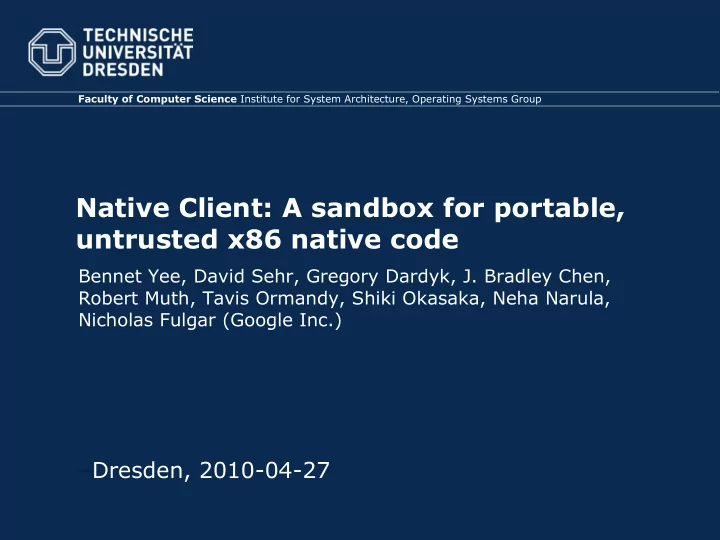

Faculty of Computer Science Institute for System Architecture, Operating Systems Group Native Client: A sandbox for portable, untrusted x86 native code Bennet Yee, David Sehr, Gregory Dardyk, J. Bradley Chen, Robert Muth, Tavis Ormandy, Shiki Okasaka, Neha Narula, Nicholas Fulgar (Google Inc.) –Dresden, 2010-04-27
Web 2.0 Slide 2 von MAXNR
Not yet Web 2.0 Slide 3 von MAXNR
Native code execution • Faster than interpreted code • Make use of platform-specific assembly (e.g., SSE) • Arbitrary code Security threat → • NaCl: framework to support safe execution of x86 machine code in a sandbox Slide 4 von MAXNR
Recap: Software Fault Isolation • Robert Wahbe, 1993 • Plugins in sub-address spaces (segments) – Segment matching: check that plugin stays within sandbox • Mostly static checks • Additionally insert runtime checks – Address sandboxing • For each memory access fix upper bits of address to segment idx – System calls & system resource accesses cross-domain → RPC • Limitations – RISC (extended to CISC: XFI, Erlingson 2006) – x86 register scarcity Slide 5 von MAXNR
Native client Slide 6 von MAXNR
Sandboxing native code • Outer sandbox: – System-call monitoring • Inner sandbox – Static checking at load-time – Dynamic runtime checks • Service runtime – System-level interface Slide 7 von MAXNR
Static checking • Reliable disassembly – All valid code within text segment – No self-modifying code • No unsafe instructions – SYSENTER, INT, segment-related instructions, RET – Ring 0 instructions • Control-flow integrity – Ensure each jmp goes to a valid instruction Slide 8 von MAXNR
Runtime checks • Indirect jumps: nacl_jump and %eax, 0xFFFFFFe0 jmp *%eax • Use x86 segmentation to enforce sandbox – Restriction: x86/32bit • Disallow (asynchronous) hardware exceptions – Would need to copy with stack segment, which is invalidated during NaCl execution Slide 9 von MAXNR
Service runtime • Unrestricted code 0 • System call trampolines NIL page 4 kB – save/restore segments Syscall trampoline – 32-byte aligned – one per system call Syscall trampoline • Springboard – Allow calls into NaCl Syscall trampoline modules – Potentially unrestricted Syscall trampoline – Start with HLT IMC socket trampoline • IMC sockets – Datagram-based Springboard return gate – Higher-level protocols on 64 kB top NaCl module 256 MB Slide 10 von MAXNR
Evaluation • Modified GCC 4.2.2 + Binutils 2.18 • SPEC2000: average 5%., top 12% overhead in NaCl mode • Near-native performance for – Computer graphics – H.264 decoding – Quake (yeah!) • Going into Google Chrome Slide 11 von MAXNR
Ben Hawks @ HAR 2009 “ This is my tentative endorsement, that, yes, Native Client could actually win … but only if they lock Tavis Ormandy in a room for a year or two … and I'm worried about the outer sandbox, so you should be too. ” Slide 12 von MAXNR
Discussion • Hack it? – Return-oriented programming works for fixed- length RISC instruction sets. – Doing harm depends on configuration of outer sandbox. Slide 13 von MAXNR
Recommend
More recommend